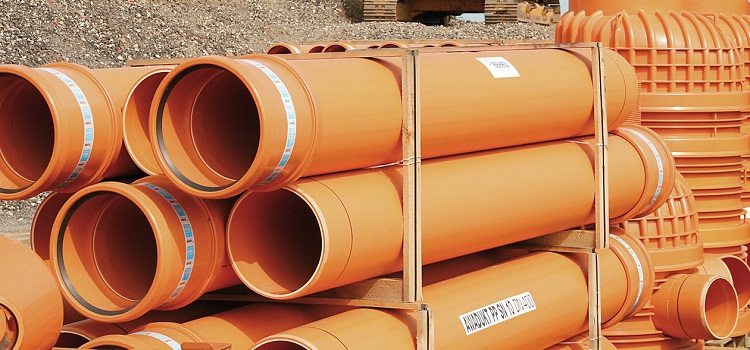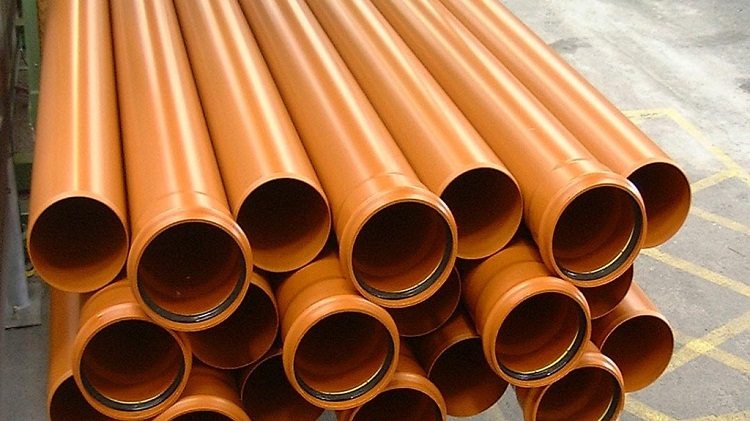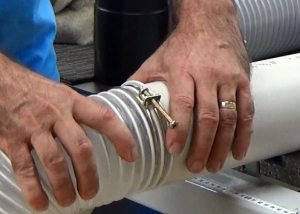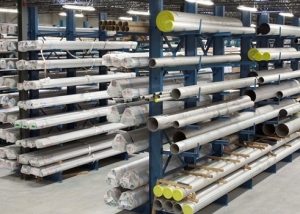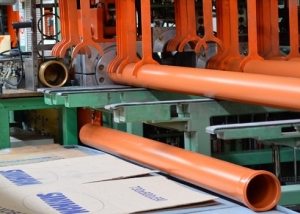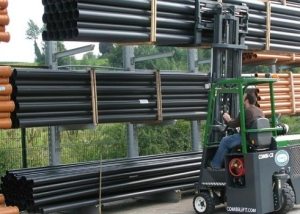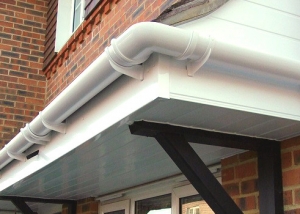The sewer system can be arranged using pipes of various materials. Steel, asbestos-cement, and ceramic were replaced by plastic channels - easier to install and operate. Distinguish between internal and external sewage network. Since they function under different conditions, the requirements for structural elements are different. For outdoor systems, PVC products are suitable, namely - red sewer pipes.
Content
Basic requirements for a sewer pipe
The requirements that apply to the pipe for the external sewage network are determined by the specifics of the structure, as well as the type and amount of wastewater. Among others, we can distinguish:
- good resistance to static and dynamic effects;
- lack of deformation under the weight of soil poured on top of the pipes;
- maintaining without damaging the load of passing vehicles and passing pedestrians;
- non-susceptibility to displacements in the docking nodes, which lead to depressurization of the sewage system, under the influence of changes in groundwater levels.
Particularly durable pipes must be used for the most critical sections of the network that experience increased external impact or cross roads. To simplify the choice of the consumer, various coloring of products helps. A gray polymer pipe can become the basis of the inside of the sewer system, and the red one from PVC can become the outside.
Properties of PVC as a material
The matrix basis of the red PVC pipe is polyvinyl chloride. The material is characterized by fire resistance, frost resistance, low melting point, and lightness. Polyvinyl chloride exhibits dielectric properties, is non-combustible, has sufficient rigidity, however, with strong impacts on bending or mechanical, it can break.
The distribution of PVC among the main materials of sewage systems is explained by its increased resistance to alkalis, acids, oil products and other aggressive substances. It is able to withstand temperatures up to 120 degrees.
Note! At this temperature, PVC loses its shape, begins to release HCl (hydrogen chloride), practically, it becomes worthless.
Deformation of products from such a material occurs already at temperature values of + 65-70 ºС. For this reason, the use of channels for hot water supply is undesirable.
The advantages of PVC pipes
Red (from orange to brick red) products for sewage during installation or transportation are able to withstand significant shock loads. They have a small coefficient of linear tension, expansion with temperature. In the absence of fluid inside the communication do not crack even in the case of complete freezing.
The red PVC pipe, while underground, does not collapse and is not susceptible to corrosion. If the sewer network is laid correctly, then pollution of the channel is excluded.This is explained by the smoothness of its inner surface, which ensures high speed of movement of wastewater and prevents the deposition of dirt. As a result, the cost of maintenance and flushing the entire system during operation is reduced.
The red pipe is easy to install, since it does not require the use of a welding machine to install it, and a conventional hacksaw for metal can be used for cutting.
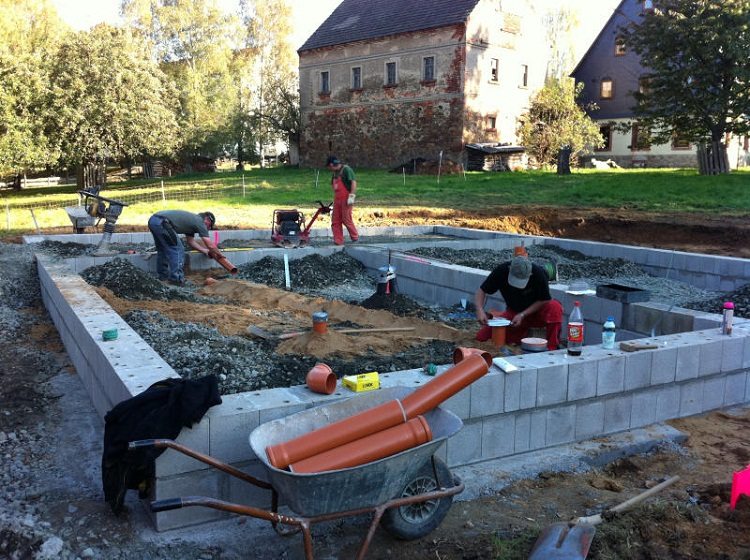
Ginger-colored pipes are able to work effectively under heavy loads, so they can be laid underground without additional protection.
Classification of red pipes for sewage
The main classification features for red PVC pipes include the production method, type of construction and degree of ring stiffness. So, according to the manufacturing method, the products are divided into single-layer and multi-layer, according to the type of design - pressure and pressureless
Depending on the stiffness category, the channels are:
- lightweight thin-walled structures (2 kN / m2, class L);
- thin-walled products of medium hardness (4 kN / m2, class N);
- rigid pipes thick-walled (8 kN / m2, class S).
The class L red pipe was used in laying the sewer system to a depth of two, class N - up to six and class S - up to eight meters.
Note! The index (category) of ring stiffness shows the value of the maximum allowable load per unit area of the product with a deformation of its vertical diameter of 4%, not taking into account the lateral resistance.
By the amount of load, location and severity, pipelines are distinguished:
- heavy type (roads, industrial areas);
- medium type (sections of small traffic);
- light type (sidewalks, green areas).
Smooth and corrugated ginger tubes are also distinguished. The second type of product is multilayer: the upper part is made of durable materials, the inside is smooth and thin. Thanks to this design, the pipe acquires good elasticity and resistance to clogging.
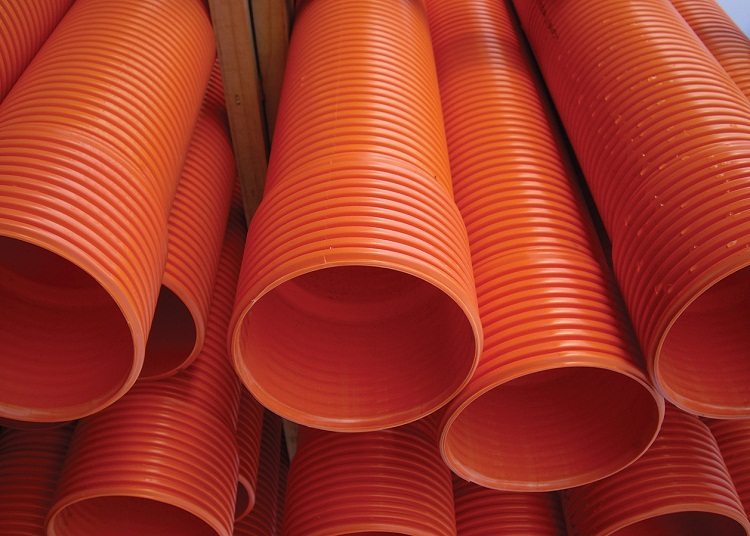
There are corrugated pipes of red color, they are multilayer and withstand higher loads than smooth ones
Pressure and non-pressure pipe
Non-pressure PVC options cope only with normal loads. Since most of the length of the system is characterized by a low load, it can be assembled from just such products.
A pressure head red pipe is necessary in those areas of the sewage system that are affected by a pump that provides normal pressure for the movement of wastewater. Such a product is also required in areas with difficult conditions and heavy loads.
Additional equipment (pump) helps to clean a septic tank or cesspool while working in an autonomous sewer network. During its operation, there is a decrease, then an increase in pressure in the pipe, which creates a certain load. In addition, there is pressure on the weight of the soil on the outer surface of the channel, which at some point can become critical to the system and lead to its breakdown.
Sizes of sewer red products
Today, red pipe products are produced in such sizes:
- length: 1-6 m;
- diameter: 110-500 mm;
- wall thickness: 3.2-14.6 mm.
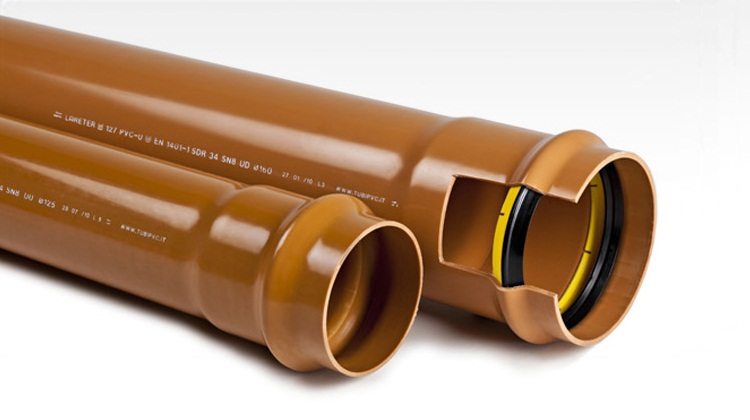
For indoor installation, pipes of smaller diameter are chosen, for outdoor installation, large products are needed
The most common are PVC channels with a diameter of 110, 160 (between buildings) and above 200 (along the street) millimeters. An external sewer system of pipes with a section of 110 mm is mounted, if required:
- withdrawal of effluents from the premises;
- installation of a sewerage network in low buildings and cottages;
- arrange a surface drainage system as a continuation of point and linear drainage.
The table shows the dimensions of some of the red tubes.
Table 1
| Outer section mm | Internal section * 10 mm | Length mm | Wall thickness mm |
| 110 | 10,36 | 1 thousand-6 thousand | 3,2 |
| 160 | 15,20 | 4,0 | |
| 200 | 19,02 | 4,9 | |
| 250 | 23,76 | 6,2 | |
| 315 | 29,96 | 7,7 |
The red PVC pipe with a diameter of 400 mm has a wall of 9.8 mm; 500 - 12.3 mm.
Note! The wall thickness is developed and selected in accordance with the diameter of the product. This value affects the permissible pipe laying depth.
For example, for a channel with a diameter of 20 cm with a wall thickness of 3.9 mm, the depth is 4 m; 4.9 mm - 6 m; more than 5.9 mm - 8 m.
Installation of an external sewage network
The external sewage system begins at the place where the pipe exits the building (building), and ends with the arrangement of a septic tank or other device for cleaning and collecting masses.
To lay the network you need:
- outline the location of the sewer pipeline in the area, indicating the location of the drainage well and septic tank;
- purchase all the required materials and pipes with a diameter of 110 mm and more, given that the minimum distance from the building to the place of wastewater collection is at least 50 meters.
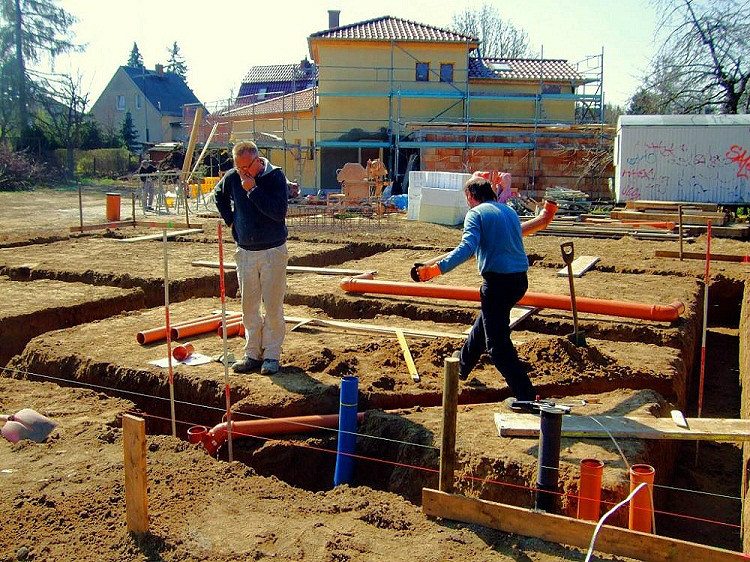
The laying of the external sewer network is carried out according to a previously thought-out scheme
There are some rules for laying the outer pipe, which include:
- digging a trench slightly wider than the diameter of the pipe;
- sand and gravel cushion at the bottom;
- additional laying of the geotextile layer (if necessary);
- installation of manholes when changing the direction of the sewer pipeline, with significant elevations, on a flat area after 6-12 meters.
After laying the pipes, the trench is dug in the same sequence. It is advisable to avoid various bends or turns of the track to prevent the risk of blockages. If necessary, you can use auxiliary parts: plugs, contours, crosses, wiring, tees, leads and others. Fittings must be made of the same material as the main part of the pipeline.
Features of the installation of channels
The pipe of red color has a bell. This design greatly facilitates its installation. The installation of channels consists in the fact that a smooth end face of an adjacent element is inserted into the socket. Waterproofing properties can be improved by using different types of gaskets. Often they are already available in the bell construction. In some cases, there are corresponding special grooves for this.
If such an element is not provided, then it is best to use a sealant for plumbing. It is evenly applied to the smooth end of the product.
Note! To improve the connection of materials will help pre-sanding part of the pipe.
After applying the sealant, you just need to insert the end face into the pipe until it stops, then push it back 10-15 centimeters, press it. The presence of a gap will avoid undesirable deformations during temperature fluctuations.
After the installation is completed, it is necessary that the pipe enters the socket by at least 4-4.5 cm. It is possible to eliminate the probability of a network accident and prevent possible freezing by performing pipe insulation. The thermal insulation of the system is carried out only after its verification - water injection for 10 minutes.
The red-colored pipe made of polyvinyl chloride is a product that has all the necessary characteristics (stiffness, reliability, etc.) for use in sewer systems.
